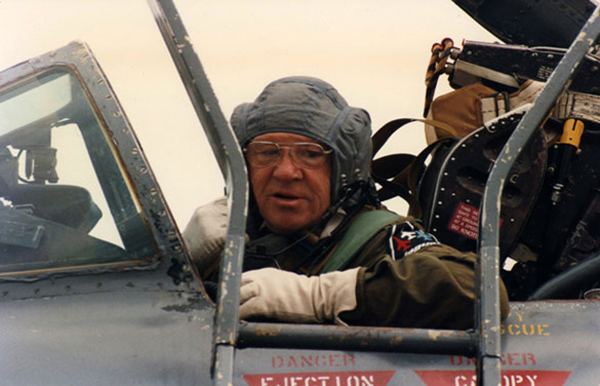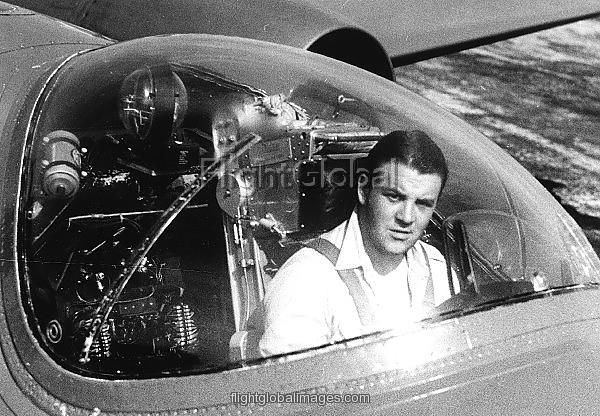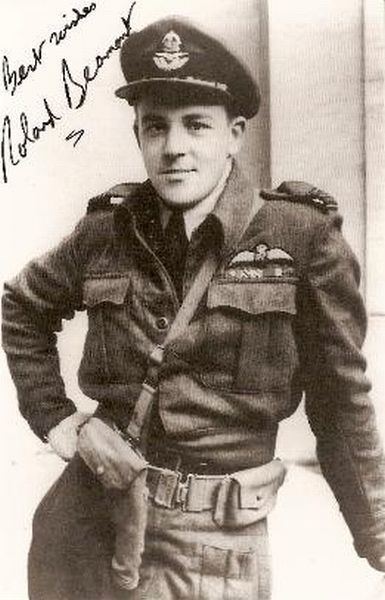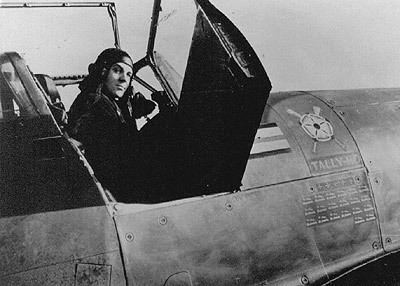Nickname(s) Bee Other work Test PilotAuthor Allegiance United Kingdom Name Roland Beamont | Years of service 1939–1979 Rank Wing commander | |
 | ||
Born 10 August 1920Chichester, Sussex ( 1920-08-10 ) Battles/wars Second World WarBattle of FranceBattle of Britain Books Phoenix into ashes, Testing years Battles and wars Battle of France, Battle of Britain, World War II | ||
P1 DEMONSTRATION
Wing Commander Roland Prosper "Bee" Beamont, (10 August 1920 – 19 November 2001) was a British fighter pilot and test pilot for the Royal Air Force during the Second World War, and the years that followed. He later became chief test pilot for the English Electric Company, where he test flew the Canberra, Lightning, and TSR2.
Contents
- P1 DEMONSTRATION
- Early life
- Hurricane
- Typhoon
- Tempest
- Meteor and Vampire
- Canberra
- Lightning
- Personal life
- Books
- References

Early life

Roland Prosper Beamont was born on 10 August 1920 at 8 Private Road, Enfield, Middlesex, the son of Lieutenant Colonel Ernest Clement Beamont, a trade officer with the Foreign Office, and Dorothy Mary, née Haynes. He grew up in Chichester, Sussex, and from an early age was fascinated by aviation. His first flight was in 1926; a barnstormer in an Avro 504 landed near his home and took Beamont (aged 6) and his father up for 5 Shillings. Thereafter, Beamont saved all his pocket money to spend it on flying books and model aeroplanes His second fight was in 1932 in a Fox Moth piloted by C.W.A. Scott.

He spent his school holidays, cycling to the Tangmere aerodrome to watch the RAF Hawker Furies fly. His parents supported his interest in aviation and had him educated at Eastbourne College from 1934 to 1937 with the aim of admission into the RAF College Cranwell In addition, his father organised two air experience flights (under the RAF's schools assistance scheme) the first at Tangmere, with No. 1 Squadron, the second at RAF Halton in which Beamont (aged 16) was allowed to take the controls in an Avro Tutor.

Beamont was not academic and failed his school certificate in 1938. He retook it after private tuition, and scraped enough passes to apply for a short service commission. On 2 September 1939 he reported to No. 13 Elementry and Reserve Training School at White Waltham Airfield for ab initio flying training as a civilian. His subsequent commission was dependant on passing the course (i.e. going solo after 15 hours tuition), which he only just managed. He was posted to No. 13 Advanced Flying Training School, Drem, flying Hawker Harts and then Hurricanes. He passed out as a pilot officer, graded exceptional, on 21 October, and in November 1939, he was sent to France to join No. 87 Squadron.
Hurricane

Beamont arrived in France with 15 hours experience flying Hurricanes. During the winter of 1939, there was little opportunity for the inexperienced pilots to fly and Beamont was assigned to the operations room. As a result of a high fever, he was sent to a hospital in Dieppe, but after two weeks absence he risked being removed from squadron strength and put into the pilots pool. To avoid this, he persuaded his father, who was also stationed in France, to provide a car to drive him back to the squadron. The spring of 1940 provided more opportunity for action. In March he took part in an interception of an Heinkel 111, on May 8 he shot down a Dornier Do17. Before the squadron left France he would shoot down a further two aircraft..

When No. 87 Squadron returned from France they were initially stationed at Church Fenton, before relocating to Exeter, as part of 10 Group, defending South Western England. During the Battle of Britain, Beamont claimed the following: a Junkers Ju 88 on 24 July, two Messerschmitt Bf 110 on 15 August, a Dornier Do17 and a Messerschmitt Bf 109 on 25 August.
Beamont described this period thus:
...I used to fly often to Portsmouth and look down upon my home, where my family was, in Chichester. Tangmere was being bombed ten miles away. It was all a very personal thing. When you got into your aeroplane, you felt the fears that everybody fears when going off to fight but overpowering all that was this feeling that if you and all your chaps didn't do your damnedest on every operation then all these Germans were going to be flooding over your country, your homes and destroying everything that was worth preserving. That was what it was all about
During the air raids of The Blitz, No. 87 Squadron was assigned night fighter duties defending Bristol. Directing the Hurricanes by searchlight was largely ineffective. In frustration, Beamont suggested that on moon lit nights they should cross the channel and strafe the Luftwaffe aerodromes. This tactic was adopted by Group and proved successful, with Beamont taking part in the destruction of several aircraft.
In May 1941 he was transferred to No. 79 Squadron RAF as flight commander, and in June he was awarded the Distinguished Flying Cross. Beamont set about raising the morale of his new flight by engaging them in night flying and formation aerobatics. In September he transported a WAAF cipher officer to a dance at RAF Pembrey in his single-seat Hurricane because the squadron's Tiger Moth was unavailable. This action would lead to his court martial in December 1941 (and his marriage in October 1942). The court found him guilty and was severely reprimanded by Group Captain Richard Atcherley.
When his tour of duty ended in December 1941, he was offered the position of Leigh-Mallory's personal aide. Instead, he chose to keep flying and to accept a position as a production test pilot at Hawker's. While he had 800 hours flying Hurricanes he was by his own admission, ignorant of the problems of aircraft stability, trim and control balance. To remedy this, Hawker's civilian test pilots, Bill Humble, Hubert Broad and particularly Philip Lucas mentored him in the art and science of test flying. At Hawker's most of his flying was production test flights of Hurricanes, but he did get occasional flights in early production Typhoons. On his first cross country flight in a Typhoon, while delivering it to Gloster's, its main oil pipe failed. He managed an emergency landing in a small field being used as a flying school, attracting a rebuke from the chief flying instructor.
Typhoon
Beamont was keen to resume operational flying in one of the two Typhoon squadrons. He was initially posted to No. 56 Squadron, as a supernumerary flight commander in July 1942, followed by a permanent posting to No. 609 Squadron RAF in October. When its commanding officer Paul Richie left in January 1943, Beamont was promoted to squadron leader.
Fighter Command had concerns about the Typhoon's safety and serviceability because during the first nine months of its introduction, the losses due to structural and engine failure were greater than caused by enemy action. As commanding officer of the few Typhoon squadrons, Beamont was instrumental in arguing for keeping the aircraft in RAF service against increasing establishment resistance. He was called to meetings with Group Captain Trafford Leigh Mallory and AOC Hugh Saunders to discuss the future of the Typhoon. Beamont argued that he had faith in the manufacturers to correct its faults and that the basic design of the aircraft was sound: it was easy to fly, a stable firing platform, it was both faster and more manoeuvrable than contemporary Luftwaffe fighters. Leigh Mallory was in agreement and the Typhoon was saved. However, it was Beamont and his squadron's actions over the winter of 1942/43 that would start to establish the Typhoon's reputation.
From March 1942 the Southern coast of England had been under attack from Luftwaffe fighter bombers. No 609 squadron was relocated to RAF Manston and in November standing patrols were set up from dawn till dusk to intercept raiding Fw 190 Jagdbombers. At the same time Beamont was developing the use of the Typhoon as an night intruder. To repeat his earlier initiative with the Hurricane, he had the illumination of his displays and reflector sight modified to be compatible with night flying. Starting on the night of 17 November, he flew a series of solo sorties; attacking trains on the Calais-Amiens-Paris line to demonstrate that the Typhoon was both safe to fly at night and an effective ground attack aircraft.
No. 91 Squadron's Spitfire XII were also deployed to intercept the raiders. Inevitably, amid inter-squadron rivalry, the question of the fastest fighter arose. Beamont challenged the CO of No. 91 Squadron to an air race, with Beamont's Typhoon being the clear victor over the Spitfire XII.
He was awarded a bar to his DSO in June 1943, his destruction of 13 trains and numerous lorries being noted.
Tempest
In mid-May 1943 he returned to Hawker's as a test pilot, performing experimental testing of both the Typhoon and new Tempest. In February 1944 AOC Hugh Saunders invited Beamont to form the first Tempest wing (No. 150), with the rank of acting wing commander. At this time the available Tempests were dispersed around maintenance units; Beamont had to fly between the units to locate them. By May 1944 his wing had become operational with two Tempest squadrons (No 3 and No 486) and one with Spitfire IX. Their first operations were ground attack sorties against trains or airfields. On D-Day+2 (8 June) the wing shot down three Me 109s over the invasion beaches without loss, the first one credited to Beamont and the first to a Tempest.
From his air field at Newchurch, Beamont witnessed the first intrusion by V-1 flying bombs as they flew towards London at dawn on 14 June; two days later (16 June) his wing was switched to intercepting them. In the following days, he and his pilots would trial attack tactics by day and discuss their effectiveness in the evening. For instance, Beamont discovered first hand that attacking a V-1 at close range could result in a hazardous explosion. He established that the best attack was to approach from astern at an acute angle with the cannons synchronised to 200yds (180m). On at least one occasion Beamont defeated a V-1 by carefully sliding his wing-tip under that of the V-1 and flipping it. His fifth V-1 kill on the evening of the 19th June made him the first V-1. ace. By the end of the V-1 campaign, 150 Wing had shot down 638, with Beamont accounting for 32. Around this time Beamont met Ernest Hemmingway. Hemmingway had flown over from America to report on the D-Day invasion and had spent time in 150 Wing's officer's mess.
On 2 October 1944, now based on the continent at Volkel, the Netherlands, he achieved his ninth and final kill of the war when he shot down a Fw 190 near Nijmegen. On 12 October, on his 492nd operational mission, while attacking a heavily defended troop-train near Bocholt his Tempest's radiator was hit by flak. He crash landed without injury and became a prisoner of war (PoW). Confined firstly to Stalag-III at Sagan in Lower Silesia, then to Stalag III-A at Luckenwalde, Brandenburg, he remained a PoW until the end of the war in Europe (May 1945). Beamont and other POWs were detained for a few weeks by Soviet forces,until they were repatriated in late May .
AT RAF Chilbolton Beamont formed the first wing of Hawker Tempest IIs in preparation for planned invasion of Japan. The Tempests were to escort bombers of Tiger Force over Japan. The operation was cancelled following the bombing of Hiroshima and Nagasaki. In May 1946 he was awarded the American Distinguished Flying Cross
Meteor and Vampire
At the end of the war Beamont was faced with a choice: a career as a test pilot or a permanent commission in the RAF. In October 1944 Philip Lucas had flown in to Vokel and invited him to become Hawker's deputy experimental test pilot after his tour. Unfortunately, during Beamont's period of captivity this position had been filled, but through Lucas he obtained an offer as a test pilot with Glosters. At the same time, he was appointed to the RAF's Air Fighting Development Unit, and applied for a permanent commission. The decision was made during a meeting with Sir James Robb, who indicated that the next phase of his RAF career was likely to be seven years behind a desk.
At Gloster, Beamont took the Meteor F4 through its early experimental test flight programme, culminating in a flight at 632 mph on 9 July 1946 in preparation for the official air speed record by the RAF. In August 1946 he moved to de Havilland as a demonstration pilot, with the aim of moving to experimental flying (particularly the DH 108 Swallow), however apart from demonstrations in the DH Vampire at air shows, the work was not challenging.
Canberra
The lack of opportunity to transfer to experimental flying at de Havilland caused him to look for more a demanding role. In October 1946 he was interviewed by Teddy Petter and Freddie Page for chief test pilot at English Electric, who at that time were designing Britain’s first jet bomber. Petter was concerned about Beamont's lack of engineering qualifications, but Page pointed out they would "have plenty of good engineers but what was needed was a test pilot with operational experience". Beamont moved to English Electric in May 1947.
At this time English Electric were manufacturing D.H Vampires under licence but had no original aircraft to conduct research, particularly to explore the effects of compressibility. From his experience at Glosters, Beamont suggested to Petter that they borrow a Meteor F.4 to carry out high altitude research. Beamont made the first experimental test flight from the Warton Aerodrome in a Meteor on 28 August 1947.
To get Beamont experience of flying big jets the Ministry of Supply organised a visit to the United States to fly the North American B-45 Tornado, the Boeing B-47 Stratojet and the Martin XB-48. When he arrived in May 1948 only the B-45 was airworthy. Through William.G.A Perring (the director of the RAE) he was able to persuade the US authorities to give him permission to fly one of the only two XP-86 Sabres then built, based at Muroc Field. Briefed by test pilot George Welch, Beamont flew the XP-86 in May of that year, exceeding an indicated Mach 1 on his one and only flight in the aircraft, the third person to do so in the XP-86.
On 13 May 1949 he made the first flight of the Canberra prototype (VN799). Due to its reserves of power and low wing-loading the Canberra was highly manoeuvrable at any altitude, and Beamont would use this to advantage in his flying.On 13 September 1949 he demonstrated it at the Farnborough air show. Flight magazine described Beamont's display as "exhilarating", stating that "A new aircraft has never been more convincingly demonstrated" . This display was only marred by the inadvertent jettison of the 'automatic-observer' when Beamont opened the bomb bay doors to slow the aircraft, necessary because the prototype had no air-brakes. On 23 February 1951 he presented it to US Department of Defense officials contributing to the decision in the April for Canberras to be built under licence by the Glenn L. Martin Company.
Beamont set two transatlantic records in the Canberra. Taking advantage of a delivery flight to Glenn Martin, he set a new record of 4 hr 18 min 29.4 sec, from Aldergrove, Northern Ireland, to Gander, Newfoundland, on 31 August 1951. The following year, Beamont had the distinction of being the first pilot to make a double-Atlantic crossing by jet, when on 26 August 1952, flying Canberra B.5 VX185, he again flew from Aldergrove to Gander and then back again to Aldergove, in 10 hours 3 minutes.
Lightning
On 4 August 1954 he made the first flight of the English Electric P1 (the Lightning prototype). On 4 April 1957 He made the first flight of the P.1B (XA847, fitted with Avon engines) and exceeding Mach 1. On 27 September 1964 he made the first flight of the TSR-2 from the Aeroplane and Armament Experimental Establishment (A&AEE) at Boscombe Down, Wiltshire.
In 1968 he retired from experimental test flying; he had flown 167 different types during a total of 5,100hr and 8,000 flights, of which more than 1,100 were supersonic. He subsequently went on to become a director of the Warton division of BAC, later BAe, as a director of flight operations. From 1970 he was responsible for the international testing of the Tornado MRCA.
In 1979 he retired from British Aerospace, devoting himself to writing and contributing to various aeronautical publications.
He died on 19 November 2001 at the age of 81.
In 2002 he was posthumously awarded the Belgian Croix de guerre.
Personal life
Beamont was a keen dingy sailor and ornithologist. On 13 October 1942, he married Shirley Dagmar Adams, the WAAF officer he had transported to the dance in his Hurricane and the daughter of the artist Bernard Robert Adams. They had a daughter Carol, born in early 1944.. Shirley died in 1945, two weeks before Roland was liberated from Luckenwalde. On 14 March 1947 he married Patricia Whitehead, the daughter of Richard Galpine Raworth, solicitor. With Patricia he had two daughters and raised her son from her previous marriage.
